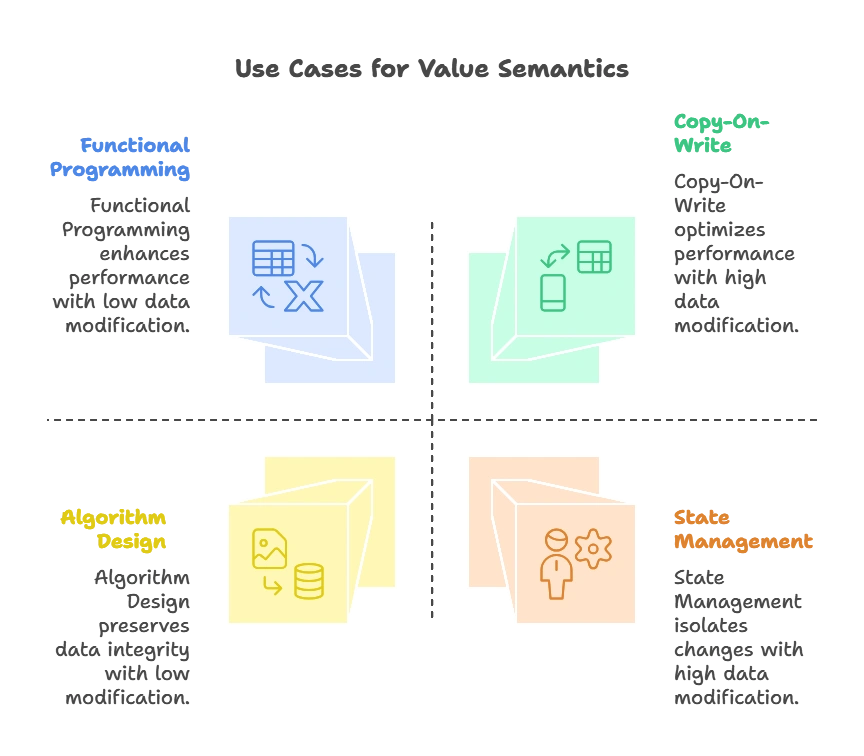Pointers vs Value Semantics
Understanding the difference between pointers and value semantics is crucial in Go programming. Pointers and value semantics represent different ways of handling data in memory, each with its advantages and use cases.
Pointers
Pointers in Go are variables that store memory addresses. They allow indirect access to data stored in memory. When you pass a pointer to a function, you’re passing the memory address of the variable rather than its value. This allows functions to modify the original data directly.
package main
import "fmt"
func increment(x *int) {
*x++
}
func main() {
num := 5
fmt.Println("Before increment:", num)
increment(&num) // Passing the address of 'num' to the function
fmt.Println("After increment:", num) // Value of 'num' is modified
}
Value Semantics
Value semantics, on the other hand, involve passing copies of data to functions rather than their memory addresses. When you pass data by value, the function operates on a copy of the original data, leaving the original unchanged.
package main
import "fmt"
func increment(x int) int {
return x + 1
}
func main() {
num := 5
fmt.Println("Before increment:", num)
num = increment(num) // Passing 'num' by value to the function
fmt.Println("After increment:", num) // Value of 'num' remains unchanged
}
- In this example,
incrementfunction takes an integer as its parameter. - Inside the function, a copy of the parameter is created and incremented by one.
- We call the
incrementfunction by passing thenumvariable by value. - The original value of
numremains unchanged because the function operates on a copy ofnum.
Advantages and Use Cases
Advantages of Pointers:
1. Efficient Memory Usage: Pointers allow for efficient memory usage, especially when dealing with large data structures. Instead of passing entire copies of data, pointers enable passing just the memory addresses, reducing memory consumption.
2. Direct Modification: Pointers enable functions to modify the original data directly. This is useful when you need to update data in place without creating new copies, leading to better performance and reduced memory overhead.
3. Shared Data: Pointers facilitate data sharing among different parts of a program. By passing pointers to shared data, multiple functions or goroutines can access and modify the same data, enabling communication and synchronization.
4. Dynamic Memory Allocation**: Pointers are essential for dynamic memory allocation using features like `new` and `make`. They allow programs to allocate memory at runtime and manipulate it as needed, providing flexibility in managing memory resources.
Use Cases for Pointers:
1. Data Structures: Pointers are commonly used in implementing complex data structures such as linked lists, trees, and graphs. By using pointers to reference other elements, data structures can be efficiently constructed and manipulated.
2. Concurrency: In concurrent programming, pointers enable sharing data between concurrent processes or goroutines safely. By passing pointers to shared data, you can ensure that modifications are visible to all concurrent entities, facilitating communication and synchronization.
3. Resource Management: Pointers are used for managing system resources such as files, network connections, and memory buffers. By passing pointers to resource handlers, programs can efficiently manipulate and release resources when they are no longer needed.
4. Function Parameters: Pointers are often used as function parameters when passing large data structures to avoid copying overhead. Functions can operate directly on the original data using pointers, improving performance and reducing memory usage.
Advantages of Value Semantics:
1. Safety: Value semantics provide safety by working with copies of data, preventing unintended modifications to the original data. This helps in avoiding bugs and unintended side effects, making the code more predictable and easier to reason about.
2. Immutable Data Structures**: Value semantics are suitable for working with immutable data structures, where data cannot be modified after creation. Immutable data structures simplify concurrency and parallelism by eliminating the need for synchronization mechanisms.
3. Functional Programming: Value semantics align well with functional programming principles, where functions operate on immutable data and produce new values without modifying the original data. This promotes cleaner and more declarative code.
4. Concurrency Safety: Value semantics inherently provide concurrency safety by preventing data races and race conditions. Since each function operates on its own copy of data, concurrent access to data does not lead to conflicts or unexpected behavior.
Use Cases for Value Semantics:
1. Functional Programming: Value semantics are commonly used in functional programming paradigms, where functions operate on immutable values to produce new values. By working with immutable data, functional programs avoid side effects and promote purity.
2. Copy-On-Write: Value semantics can be used in copy-on-write strategies, where data is copied only when necessary. This is useful for optimizing memory usage and improving performance when dealing with large data structures.
3. State Management: Value semantics are suitable for managing state in applications where data is frequently updated or modified. By working with copies of data, changes to state are isolated, preventing unintended side effects and enhancing reliability.
4. Algorithm Design: Value semantics are often preferred in algorithm design when the original data needs to be preserved for future reference. By operating on copies of data, algorithms can be implemented without modifying the original input, ensuring data integrity and repeatability.

Understanding the distinction between pointers and value semantics is essential for writing efficient and maintainable Go code. Pointers allow for direct manipulation of data and efficient memory usage but require careful management to avoid bugs. Value semantics provide safety and simplicity by working with copies of data but may incur performance overhead when dealing with large data structures. By choosing the appropriate approach based on the requirements of the program, developers can create robust and efficient Go applications. Happy coding !❤️
